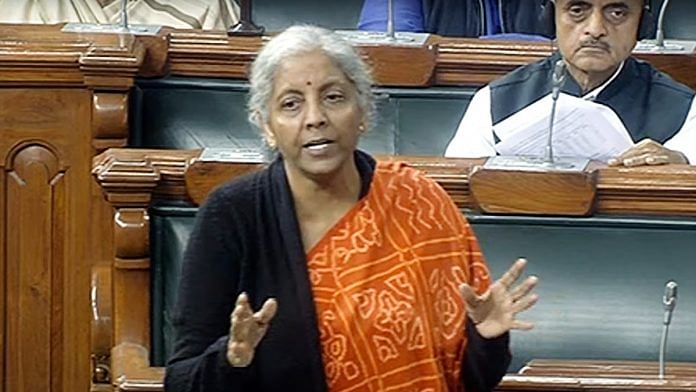New Delhi: The value of currency notes in circulation has more than doubled and there has been a 30 per cent increase in the volume of notes in circulation since demonetisation in 2016, the Modi government told Parliament Monday.
Reduction of notes in circulation and gradual migration to a less cash economy was one of the stated goals when the government in one fell swoop announced in November 2016 that Rs 500 and Rs 1,000 notes then in circulation would no longer be legal tenders.
Replying to a question from Dravida Munnetra Kazhagam (DMK) MP Velusamy P, Finance Minister Nirmala Sitharaman told the Lok Sabha that the value of notes in circulation dipped marginally from Rs 16, 41, 571 crore on 31 March 2016 to Rs 13,10,193 a year later (2017).
Demonetisation was affected on 8 November, 2016, so this dip was in the immediate aftermath of that decision. However, the value of notes in circulation, far from going down, has been on an upward trajectory since, touching Rs 18,03,709 crore in 2018 and standing at Rs 31,05, 721 crore in 2022. In 2019 that value was Rs 21,10,892 crore, in 2020 it was Rs 24,20,975 crore and in 2021, it was Rs 28,26,863 crore. On 2 December this year, the value stood at Rs 31,92,622 crore, Sitharaman said.
The finance minister, however, did not provide data on notes in circulation as a percentage of GDP, which is a more accurate assessment of cash usage in an economy.
A total of 90,266 million pieces of currency notes had been in circulation on 31 March 2016. It had gone up marginally at the end of the 2016-17 financial year when it stood at 1,00,293. It has been steadily going up since to 1,02,395 in 2018, 1,08,759 in 2019, 1,15,977 in 2020, 1,24,367 in 2021 and 1,30,533 in 2022, Sitharaman told the House.
These changes happened despite a slew of measures to promote cashless transactions undertaken by the government at various levels.
“…section 269SU was inserted to the Income-tax Act, 1961 (the Act) so as to provide that every person, carrying on business, shall provide facility for accepting payment through the prescribed electronic modes, in addition to the facility for other electronic modes of payment, if any, being provided by such person, if his total sales, turnover or gross receipts in business exceeds fifty crore rupees during the immediately preceding previous year,” Sitharaman told the House as part of her account of the measures undertaken to promote a digital economy.
She added: “In order to ensure compliance, section 27IDB was inserted to provide that the failure to provide facility for electronic modes of payment prescribed under section 269SU shall attract penalty of a sum of five thousand rupees, for every day during which such failure continues.”
Also Read: Rs 2000 notes mean ‘black money’, phase them out gradually — BJP MP’s plea to Modi govt
The ‘ills’ of cash
In his address to the nation on 8 November 2016, Prime Minister Narendra Modi had, while announcing the move to demonetise higher value currencies, outlined the reasons for the drastic measure, highlighting the urgent need to crack down on terrorism and the black money that is often used to fund it.
On the need to decrease cash in circulation, he had said that the magnitude of cash in circulation is directly linked to the level of corruption. “Inflation becomes worse through the deployment of cash earned in corrupt ways. The poor have to bear the brunt of this. It has a direct effect on the purchasing power of the poor and the middle class. You may yourself have experienced when buying land or a house, that apart from the amount paid by cheque, a large amount is demanded in cash. This creates problems for an honest person in buying property.”
He had further said that misuse of cash had led to artificial increase in the cost of goods and services like houses, land, higher education, healthcare etc. “High circulation of cash also strengthens the hawala trade which is directly connected to black money and illegal trade in weapons. Debate on the role of black money in elections has been going on for years.”
(Edited by Anumeha Saxena)
Also Read: ‘Increased digital payments, pushed growth’: How govt defended demonetisation policy before SC



